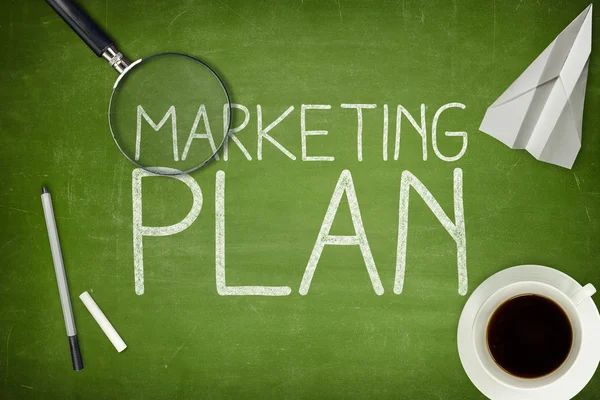
Marketers have a saying: “If you don’t know where you’re going, any road will take you there.” Without planning and a sound strategy, how can you know where you are going or what you need to do to get there? Here are 10 steps to developing your marketing plan.
Before jumping into tactics and execution, your marketing team should ask the leadership team to define their business goals for the next 1-3 years. Your goals may be externally focused, internally focused, or perhaps a mix of both.
When developing goals (business or otherwise), write them in the smart format that ensures accountability. Smart stands for Specific, Measurable, Achievable, Realistic, and Time-bound and represents business goals such as:
- Increase product line revenue by 30 percent to $2 million in the next 12 months
- Double income through distributors in the next two years
- Increase profitability from 25 to 30 percent by the end of the year
While you’re setting business goals, make sure you also set a marketing budget for the year. A good rule of thumb for setting a marketing budget is 6-12% of gross revenue with more spending in the early phases as you establish your marketing foundation.
Ultimately, you want marketing that provides a consistent stream of high-quality leads to help fuel new sales opportunities and drive growth. You want your audience and technical customers to be happy to hear from you and not afraid of you. And you have a limited budget and tight bandwidth.
What are the steps to develop a marketing plan?

Build it and they will come. It is a well-intentioned sentiment. But when it comes to running your own business, you miss the mark a bit.
As you already know, you can’t just set up the store and cross your fingers that people find you. Instead, owning a successful business means constantly marketing and promoting your business in hopes of getting more eyeballs on your product or bodies through the door.
But, the words “marketing plan” are enough to send chills down anyone’s spine. Sounds too technical and downright daunting, doesn’t it? I assure you, though, it’s not as intimidating as you might think it is, and you definitely don’t need a marketing degree to figure it out.
Follow these seven simple steps and you will be armed with a marketing plan that is sure to help you take your business to the next level!
Before you can jump right into creating your plan, it’s important to have a solid understanding of exactly what it is. Usually included as an expanded piece of your overall business plan, a marketing plan is exactly what it sounds like: a document detailing everything you need to know to successfully promote your business.
Some large corporations have marketing plans that are hundreds of pages long, while a small one-person business might only have a handful of pages. There is no exact length for this type of document, as long as you have included all the necessary information.
How to make a marketing plan that is and keys?
Does your business have a solid marketing plan to attract and retain customers? If not, you definitely should. A solid marketing plan can be the difference between your business succeeding by winning new and retaining existing customers, or going extinct by being too happy with conflicting customer referrals. Don’t get us wrong, customer referrals are a great source of business, but if there was a new competitor to come in and start taking over the market, you won’t be left with nothing. This blog can help you develop a solid marketing plan to expand your business.
A market analysis is important to understand where your business is. This will help you develop an action plan based on the information you’ve gathered here. A wide range of topics should be discussed, starting with your current message and brand message. This will allow you to see if you have a consistent brand image and message across all media and aspects of your business. A full market analysis must also be completed, which will include an analysis of the competition, volume and value of a market and any environmental factors beyond their control must be evaluated. The information gathered in the market analysis will form a solid foundation for the rest of the marketing plan.
2. Define your marketing objectives The development of objectives is vital to a marketing plan. Having measurable and realistic marketing goals is a key aspect of a successful marketing plan. These goals should identify key performance indicators (KPIs) to measure your progress throughout the plan. These marketing goals should also tie in closely with your business goals to ensure there is no confusion or misdirection in which the business is headed. An example of a goal for a marketing plan might be to increase leads by 25% percent, or increase total sales revenue by a certain percent over the next year. These are measurable goals and can be set realistically.
https://www.malyksolutions.com/digital-services/marketing-strategy/3. Develop your marketing strategy Developing a solid strategy is one of the most important parts of the entire marketing plan. If done correctly, this strategy will allow you to achieve your goals outlined in the previous sections of the plan. The strategy should at least include which segment you will be targeting, your branding and positioning strategy, and a content and engagement plan. This strategy is the biggest part of the plan, as it outlines exactly how you are going to achieve your goals. This strategy should include the main challenges for your business, such as generating leads, and describe how they will be overcome. A good inbound marketing strategy can help you get solid leads and drive more traffic through your website.
What is a marketing plan and its parts?

A marketing plan is a document that lays out your marketing strategy for the coming year, quarter, or month. A marketing strategy often comprises the following elements, a summary of your company’s marketing and advertising objectives, a summary of your company’s current marketing position, a timetable for when your strategy tasks will be completed, and an outline your company’s target market and customer requirements. .
Learning to build a marketing plan pushes you to consider the critical phases that lead to a successful marketing strategy. A well-defined plan can also help you stay on track with your high-level marketing goals.
The video below is a brief summary on the components of a marketing plan.
The marketing plan is the missing link between the strategic direction of the business and the achievement of results. It’s the glue that holds everything together and ensures the right activity is delivered to the right audience through the right channels at the right time.
If you’ve ever felt like you’re trying too many different things at once without understanding what works and what doesn’t, you’re missing out on a marketing plan. Likewise, if you think your actions are particularly insular and may conflict with other aspects of the business, you lack a definite plan.
Magic happens when your business strategy, marketing strategy, and marketing plan are in perfect alignment. That’s when the little things you do on a daily basis start to add up to a bigger picture of where your business is headed and you start to see much better returns on your investment.
What is a marketing plan and describe its parts?
Marketing should always start with a complete marketing plan, which allows you to assess the market potential for your products or services and develop strategies to fulfill that potential. A complete, written marketing plan contains seven main components:
1. Market research and analysis: The first component of a marketing plan allows you to gather relevant information about the potential market for your products and/or services, assess the strengths and weaknesses and identify a target audience.
2. Marketing and Financial Goals and Objectives: This component of a marketing plan involves defining your marketing and financial goals and objectives. Goals and objectives will help you focus and evaluate your marketing efforts.
3. Marketing Mix – The marketing mix component of a marketing plan outlines the specific strategies you will implement to reach your target audience, entice the target audience to spend their money, and create a desire in them to return to your business. Strategies are developed that cover the 4 P’s of marketing (product, price, place and promotion).
4. Marketing Budget – This component of a marketing plan involves developing a marketing budget, which will allow you to plan for marketing expenses.
5. Monitoring and Evaluating Market Response – This component of a marketing plan outlines the strategies you will use to monitor and evaluate market response to your marketing strategies. Evaluating the effectiveness of your marketing plan will allow you to make adjustments to meet your goals.
6. Contingency Plan – The contingency plan outlines possible adjustments to make to your strategies if your marketing tactics are more or less effective than originally planned.
7. Marketing Plan Checklist – The final component of your marketing plan is a marketing plan checklist. This checklist allows you to summarize the tasks that need to be accomplished to put your plan into action.
Additional information on marketing is available from the University of Tennessee Center for Profitable Agriculture. In particular, the publication called “Marketing for the Value-Added Agricultural Enterprise” discusses the development of a marketing plan.
This work is supported in part by the New Technologies for Agriculture Extension Grant no. 2022-41595-30123 from the USDA National Institute of Food and Agriculture. Any opinions, findings, conclusions, or recommendations expressed in this publication are those of the authors and do not necessarily reflect the views of the United States Department of Agriculture.
What parts does the marketing plan have?
Marketing, at its core, is getting people to know, like and trust your business. In more business language, it’s planning everything you do to attract and build relationships with current and future customers. It starts with the target market strategy and product market fit. It includes tactics such as pricing, distribution, advertising, and promotion. And it presents concrete details of dates, deadlines, milestones, responsibilities and budgets.
Every good marketing plan is unique; It has to adapt to each business. It reflects your goals and objectives and your strengths and weaknesses. You understand the industry you are in. It is sensitive to its resources, its niche. You don’t find a marketing plan, you create your marketing plan. Here are some of the common steps.
A good marketing plan is a marketing plan that you can track, so use measurable objective numbers to track your progress. Not just sales: include metrics like users, views, visits, inquiries, leads, posts, likes, follows, calls, etc.
You can’t track progress without good numbers to show your starting points. One way to test the value of different measurements is if you can accurately establish their baselines.
Your user personas are images and stories of your ideal customers. These are one or more imagined personas that help you imagine potential customers. You can imagine their likes and dislikes. How do they find you? What problem does your business solve for them? How do you get the word? What are they looking at?
What does a marketing plan have to contain?

To grow your business, you need a marketing plan. The right marketing plan identifies everything from 1) who your target customers are, to 2) how you’ll reach them, to 3) how you’ll keep your customers buying from you again and again.
Done right, your marketing plan will be the roadmap you follow to gain unlimited customers and dramatically improve your organization’s success. To help you succeed, use this proven marketing plan template, and the information below details the 15 key sections to include in your marketing plan.
Fill in your executive summary last, and as the name suggests, this section simply summarizes each of the other sections of your marketing plan.
Your executive summary will be helpful in giving yourself and other constituents (eg, employees, consultants, etc.) an overview of your plan.
This section describes the customers you are targeting. It defines your demographic profile (eg age, gender), psychographic profile (eg your interests), and your precise needs and needs in relation to the products and/or services you offer.
Being able to more clearly identify your target customers will help you identify your advertising (and get a higher return on investment) and better “speak the language” of potential customers.
Having a strong Unique Selling Proposition (USP) is critically important as it sets your business apart from competitors.
The hallmark of several great companies is their USP. For example, FedEx’s USP of “when you absolutely, positively have to be there overnight” is well known and resonates strongly with customers who want reliability and fast delivery.